Trout Fishing Tips: Guide Tips And Tactics For More Trout
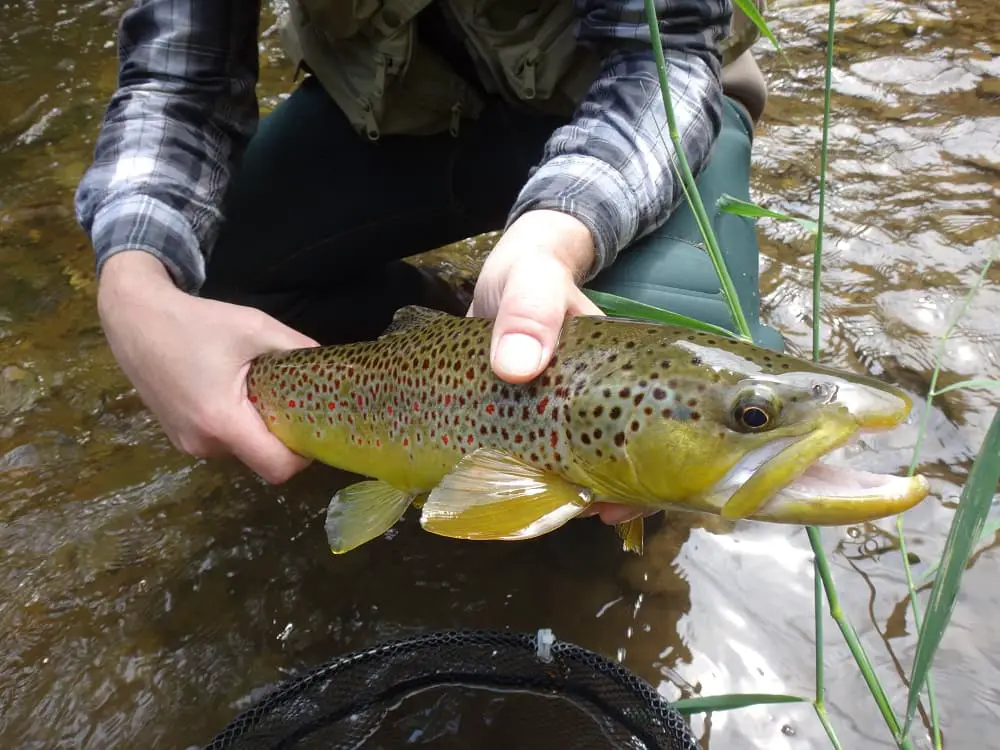
If you want to get started in trout fishing or you want to catch more trout, you need to know where to go, how to find the trout in the river, what methods and baits to use, and how to use them well. But there is more. Knowing this will make trout fishing much more effective.
Like all articles on our site, the information, tips, and tactics are proven effective and used by top guides with over 20 years of experience.
Trout Fishing Tips: The Species
The most common trout are rainbow trout, brown trout, brook trout, and Cutthroat Trout.
In some areas of North America, you might also find Bull trout, Tiger trout, or Palimono trout. For the most part, you can catch all these trout species using the same methods described here.
How To Get Started Fishing For Trout
Trout feed on insects, fish eggs, worms, other fish, leeches, mice, and frogs.
When trout fishing, you will want to use lures or baits that imitate the trout’s natural food source, and you want to use methods and gear that allow you to present your bait as naturally as possible.
The six things you need to get started trout fishing are:
- A valid Fishing License for your state or province and maybe a trout tag.
- A trout rod, reel, and suitable line.
- The terminal tackle includes weights, hooks, floats, leader, net, release pliers, and the knowledge of how to put it all together.
- Baits or lures that work well for trout
- A trout river, lake, or pond near you.
- The knowledge of how to catch trout.
I cover all that and more on this page.
Do You Need A Fishing License Or A Trout Tag For Trout Fishing?
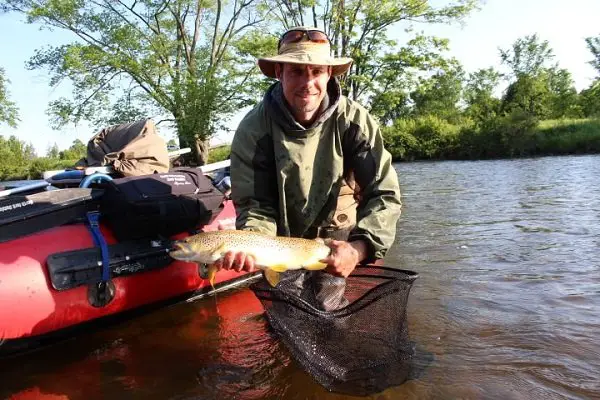
As far as I know, every state or province requires you to have a fishing license and maybe a trout tag to go with that fishing license.
The government website should have all the accurate information on how and where to get a fishing license or a trout tag.
Know The Trout Fishing Regulations And Seasons For Your Area
Some states and provinces have trout seasons, which are set times of year you are permitted to fish for trout.
Special regulations may also apply, such as delayed harvest, harvest amounts, size limits, and special regulation zones that may be for catch-and-release only, fly fishing only, single hook only, no bait, or no fishing after sunset.
It is your responsibility to know the laws and rules for the body of water you are going to fish. Check your local regulations before you go fish for trout.
What Are The Best Trout Fishing Rods?
Most trout are on the smaller side averaging from six inches to 14 inches and weighing under two pounds, and they can be found in streams from three feet wide to over 100 feet wide.
That means most standard 7-foot light and medium-action spinning rods will do the job. Different rods may be required in different types of water or for different methods.
The best all-around trout rod for most trout rivers between 10 and 40 feet wide would be a 7-foot light action spinning rod. Check out my page Best River Fishing Rods For Trout or Best Rods For Float Fishing.
Rod Type | River Type | Fish Size | Lures | Float Fishing |
5 to 6 foot - UltraLight Action | Small creeks - 3 to 12 feet wide | Under 14" Trout | Small 1 to 2 inch spinners, spoons and crankbaits | Very small floats, Small baits, Little to know weight |
6 to 7 foot Light Action | Small creeks and rivers- 12 to 25 feet wide | 6" to 20" Trout | Small 1 to 4 inch spinners, spoons and crankbaits | Small to medium floats, Most baits, Some weights |
7 to 8 foot light action or Med - Light Action | Larger creeks and rivers- 16 to 50 feet wide | 14" to 30" Trout | Small to large spinners, spoons and crankbaits | Medium To large floats, All baits, Fair amount of weight |
9 to 11 foot Med-Light Action | Best for medium to large rivers- 16 to 50+ feet wide | 14" and up to 10 pound trout - Good for great lakes steelhead | Medium to large spinners, spoons and crankbaits | Medium To large floats, All baits, Fair amount of weight |
10 to 13 foot - Med-Light Action | Best rod for bigger rivers of 25 to 80+ feet wide | Best for bigger trout and steelhead over 16" | Medium to large spinners, spoons and crankbaits | Best rods for float fishing with floats |
You could also fly fish for trout, in which case you will need an appropriately sized fly rod for that.
What Are The Best Trout Reels For Trout Fishing?
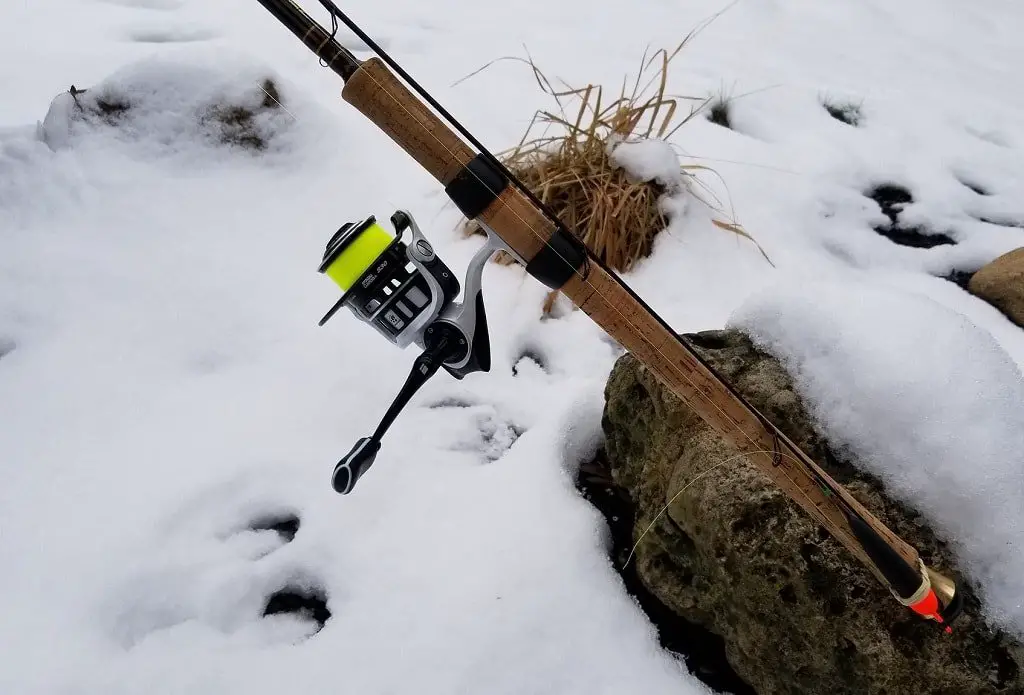
The best trout reel for most trout rivers would be a size 2000, but you may need to go down to a smaller size 1500 or even size 1000 for very small creeks and small trout, or you may need to go up to a size 3000 for large rivers and larger trout.
Use my Reel Sizing Chart as a guide when purchasing your next reel.
If you are not sure what a good trout reel is, check out my page on the Best Spinning Reels where I show you the reels that I and other guides use.
Reel Size | River / Water Type | Fish Size | Lures | Float Fishing |
Size 10 or 1000 | Best for very small creeks 3 to 12 feet wide - To small for lakes | Best for small trout under 12 inches - or panfish and ice fishing | Best for small 1" to 2" light lures or jigs. | Good for very small floats and small baits with little or no weights |
Size 15 or 1500 | Good for small creeks and rivers from 3 to 20 feet wide - To small for lakes | Good for small trout under 16 inches - or panfish and ice fishing | Good for small 1" to 3" light lures or jigs. | Good for small floats and small baits with some weights |
Size 20 or 2000 | Best for small to meduim creeks and rivers from 10 to 40 feet wide - A bit small for lakes | Good for trout from 10 to under 25 inches - or panfish and ice fishing | Good for small 1" to 4" lures or jigs. | Good for most floats and small baits with some weights |
Size 25 or 2500 | Best for meduim to larger rivers from 16 to 80 feet wide - Good for lakes | Best for bigger trout up to 30" and great lakes steelhead in smaller rivers | Good for medium to large lures 2" to 7" lures or jigs. | Good for most floats and all baits with plenty of weights |
Size 30 or 3000 | Best reel for meduim to large rivers from 30 to 100+ feet wide - Good for lakes | Best for larger trout and great lakes steelhead | Good for medium to large lures 2" to 7" lures or jigs. | Good for most floats and all baits with plenty of weights |
Size 40 or 4000 | Best reel for meduim to large rivers from 30 to 100+ feet wide and lakes | Good for large fish like salmon, steelhead, Pike and Musy | Good for medium to large lures 2" to 7" lures or jigs. | Good for most floats and all baits with plenty of weights |
Size 50 or 5000 | To Big - Not recommended for rivers - Good for trolling, and ocean fishing and surf casting | Best for salt water fish, salmon, and large musky | Good for very large lures 7" to 12" lures or heavy jigs or weighted rigs | Good for most giant floats and big baits where lots of weights is required |
What Are The Best Trout Fishing Lines?
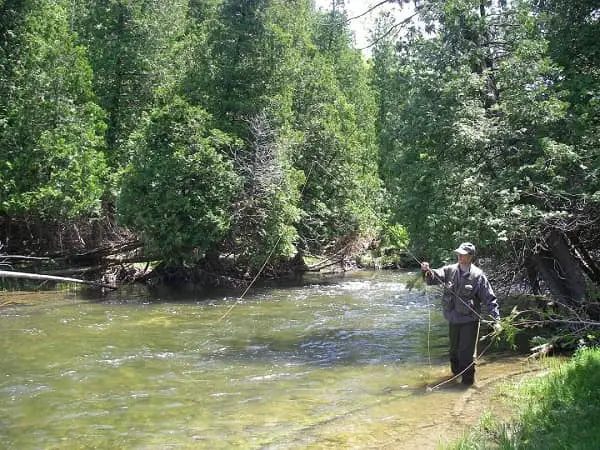
A good trout line will be strong, thin, and smooth and good for both casting lures, jigs, and for float fishing with bait. For most trout rivers and trout sizes, a 6lb to 8lb monofilament line or a Braided line (of 6 to 8-pound diameter) would be perfect.
The best trout lines for all sizes of trout are from reputable brands, and one’s that guides and other anglers have put to the test:
- Best For Casting and Float Fishing – Sufix Elite Line.
- Best For Float Fishing – Raven Mainline.
For more details on these and other lines and to see which ones I use, check out my page on The Best Lines For Trout and Steelhead.
For a line that is only for float fishing for trout and steelhead, I use a bright-colored line with a clear fluorocarbon leader, but for a line that is good for casting lures, I use a clear line.
See The Best Leaders and Setup.
Is Corn A Good Bait For Trout?
There are two types of trout baits. High-percentage baits, which are baits that good trout guides and anglers use, and low-percentage baits such as corn, which are used by uneducated anglers. Do yourself a favor and only use High-Percentage baits.
If you want to make it harder for yourself, go ahead and use corn. See Trout Fishing With Corn page.
Do Trout Like Marshmallows?
Trout will eat small marshmallows or chucks of marshmallows because they might look like fish eggs or maybe because they are just attractive looking to the trout.
But for the same reason as corn, there are much better baits for trout than marshmallows. Stick with what works better, and you will catch more trout. See Trout Fishing With Marshmallows article.
Do Scents Work For Trout?
In my opinion, scents do not make much of a difference in whether a trout eats a bait or not.
Based on 36 years of trout fishing and experimenting with scents, I would say that 90% of the food a trout eats has very little or no scent at all, and often, the food drifting down the river is so far out of the trout’s direct feeding path that they do not pick up on the scent anyways.
I believe trout feed far more based on sight than on scent. Anglers should focus more on colors, size, shape, and presentation and less on how their bait smells.
Do Trout Like Garlic?
Garlic smell repels many things, but what about trout?
I have read that trout do like garlic scents, but like many things on the internet, it doesn’t come from a reliable scientific source, and in my opinion, trout neither like nor dislike garlic or garlic scents. Garlic as a scent WILL NOT significantly increase the amount of trout that you catch.
There are a bunch of commercial garlic scents out there that claim that garlic works, but I have tried some garlic scents, and I’m still a skeptic.
Should You Use A Bobber When Trout Fishing?
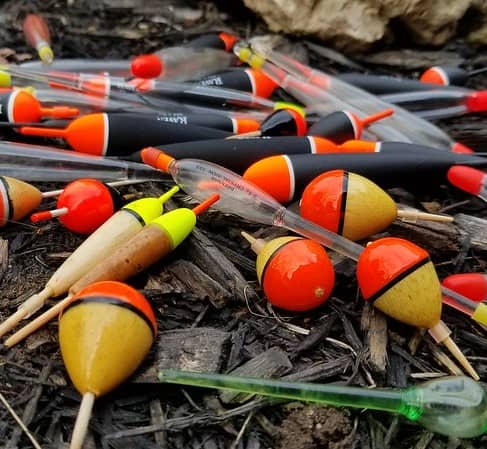
When fishing for trout in bigger rivers or bigger spots, bobbers are one of the best ways to present your bait to trout in a river.
Ensure you use the right bobbers since some are better in rivers than others.
The narrow river bobbers known as floats are the only bobbers you should use.
If you want to know the floats I use and recommend, see Best Floats For River Fishing.
Are Lures Good For Trout?
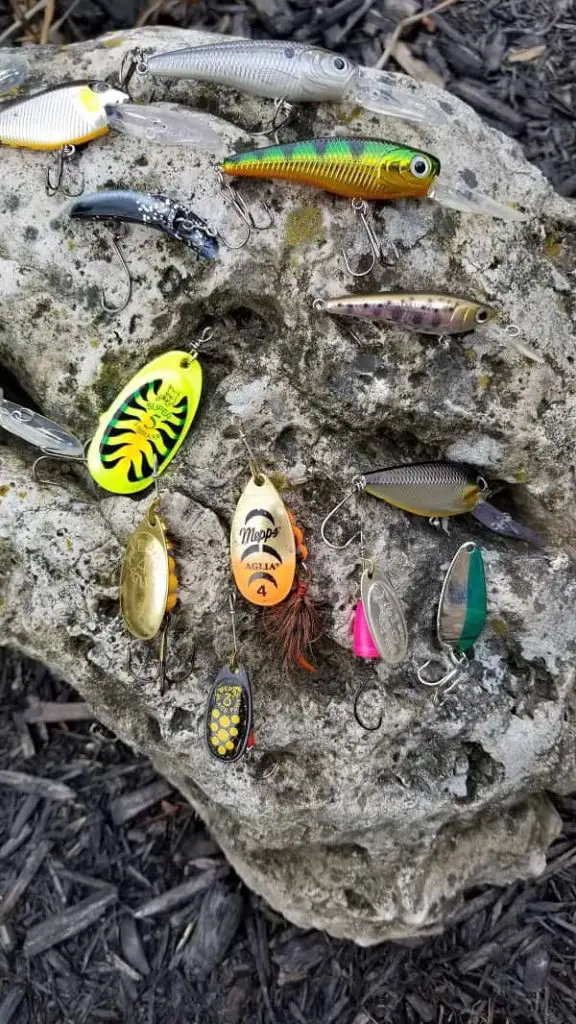
Lure fishing for trout is good because both big and small trout will eat a well-presented lure.
Lure fishing is also fairly easy to do. If you want to catch trout, then fishing with lures is a great way to get started.
Learning how to fish lures effectively significantly improves your results.
In part one of Trout Fishing 101 – How To Fish For Trout, I explain in more detail how to fish with lures and how to cover the water better.
I also discuss in more detail how to fish different lures and my best lures for trout at Lure Fishing For Trout: Tactics From A Pro River Guide.
Some good lures for trout include spoons, spinners, jigs, and crankbaits. Shiny lures tend to work best most of the time, but not always. I will discuss fishing with lures more below.
What Is the Best Size Lure For Trout?
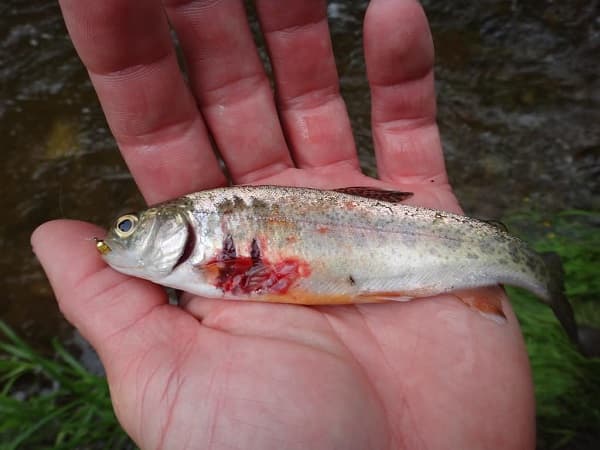
Most good trout lures are 1 to 3 inches long, but for bigger trout over 20 inches long, I have caught them using lures that are 5 and 6 inches long.
It’s important to try different lure sizes starting with the smaller ones first, and working up to the bigger sizes to see what the trout want.
What Is The Best Lure Colors For Trout?
The best lure colors are silver, gold, and colors that imitate the natural food source like olive sculpins, tan or silver minnows, or black leeches.
Bright colors like chartreuse, pinks, and oranges can also be good colors for trout. I will often start with a darker color and then switch to a brighter color to see what the trout want.
Best Bait For Trout
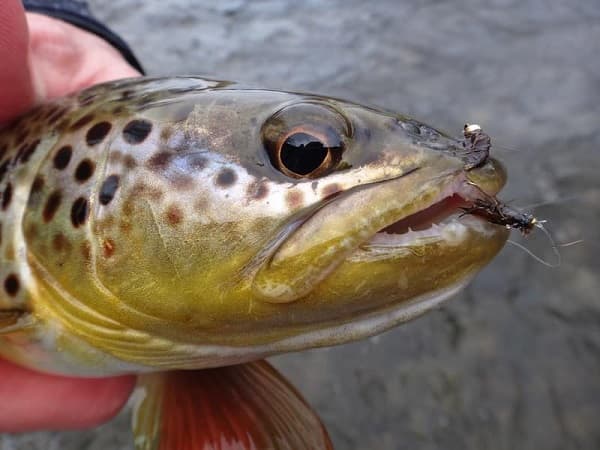
Under certain river conditions, some trout baits will be better than others.
The best baits for trout are:
- Live garden worms
- Plastic worms
- Egg sacks
- Single salmon eggs
- Trout beads
- Live grubs
- Maggots
- Minnows
- Artificial flies.
I have an entire page dedicated to using and fishing with egg sacks, also known as spawn sacks or roe bags.
I also have a full page on my Best Trout Bait – The Only 5 Baits You Will Ever Need, how I use them, and how you can make these baits more effective.
I have a page for the Best Trout Flies.
The Bait Matters Least
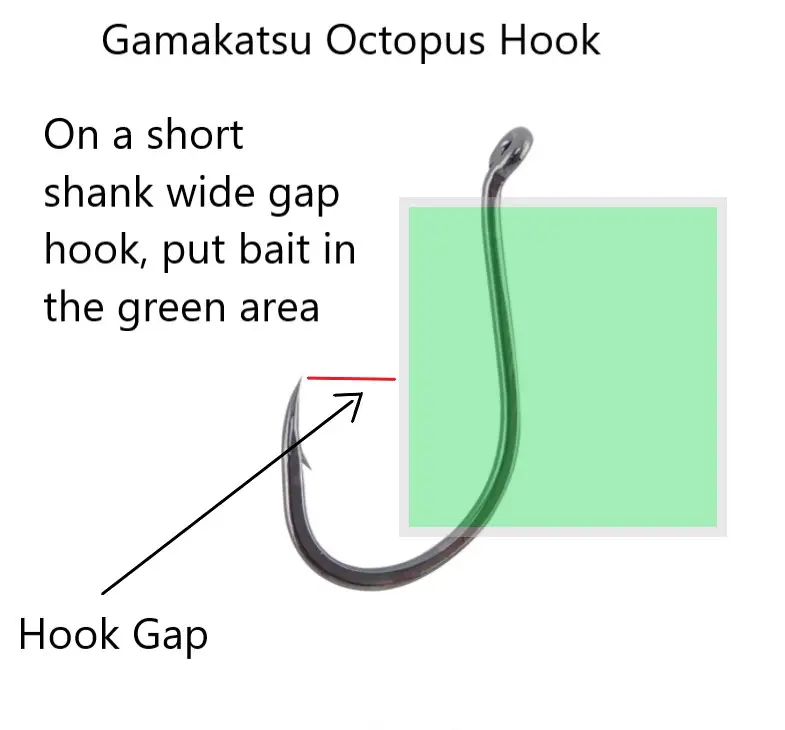
Just because you know what the best bait is doesn’t mean you will catch fish. Very often, I see anglers with good baits CATCH NO FISH!
To make your bait work better, you MUST follow these rules
- Leader Set-Up: Your leader must be set up in a way that allows for a good presentation, and should be the right size and length so the fish do not see it.
- Hook: Your hook MUST be the right type and the right size for the bait you use.
- Bait: Think about how the bait would look to the fish if it were drifting in the river with no hook or a line attached to it, then try to replicate that. Ensure you put the bait on properly and do not cover the hook point or close the hook gap.
- Presentation: If you do not present your bait properly, trout will not grab it.
- Approach: Knowing how to approach and fish a spot will greatly increase your chances. If you spook the trout before you start fishing, your bait is useless.
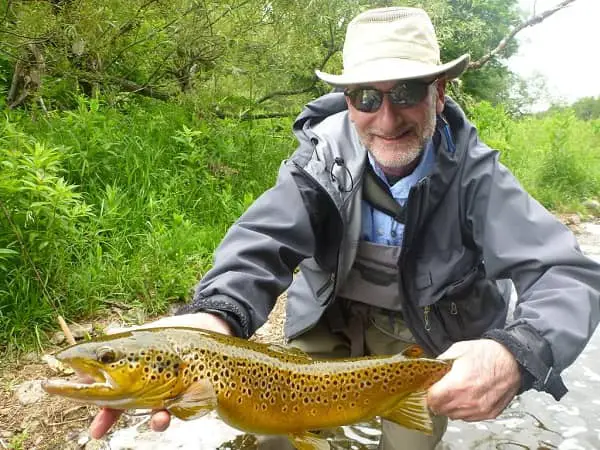
See the right hooks for bait and Fishing With Worms For Trout and Steelhead: 10 Guide Tips
You need to drift from the top of the pool or run to the bottom of the pool or run in a way that looks most natural to the fish. Do this with all your baits, and you will catch more big trout.
What Size Hooks For Trout Fishing?
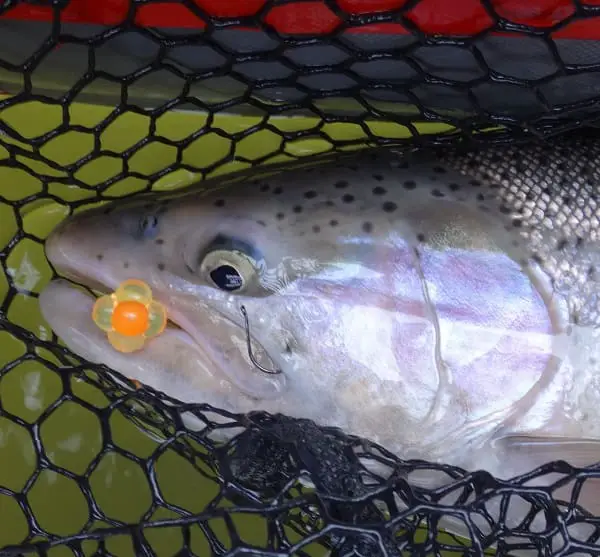
You need a good hook that is not too big and not too small and matches the size of the bait. The best hook size for trout is between a size eight and a size 12.
If your hook is too big, the trout will see it, and a hook too big can also weigh the bait down, preventing it from getting a good natural drift.
I have a page dedicated to the Best Hooks that I use for trout.
Do Trout See Color?
There are studies that indicate the trout do see colors in clear water and in shallower waters where there is plenty of light.
The deeper the water, the less light passes through and the less color a trout can see. Trout will see blues and reds the most, but in lower light conditions, colors start to become shades of grey and blacks.
Is Fly Fishing Good For Catching Trout?

Fly fishing is an excellent way to catch trout in rivers. With fly fishing, you can effectively imitate the natural insects that the fish feed on below the surface and on the surface making it one of the most effective ways to catch trout.
I have an entire section on fly fishing for trout, steelhead, and salmon in rivers if you are interested in learning how to fish for trout using a fly rod.
Is Centerpin Fishing For Trout Good?
Centerpin fishing for trout in larger rivers can be the most productive way to catch trout. You can also Centerpin Fish in smaller rivers by adjusting your technique a bit.
I have an entire section on Centerpin Fishing.
How To Catch More Trout
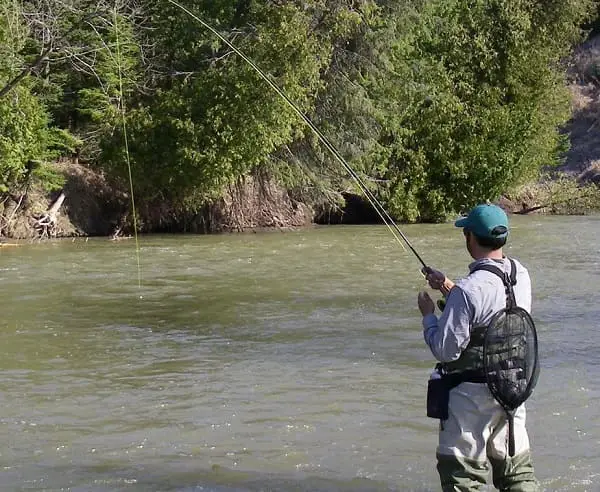
I often tell my clients it’s not one big thing that I do well that helps me catch so many trout; it’s a lot of little things I do well that makes me a successful angler.
As an angler learning how to catch trout, it’s a good idea to know and do all these little things well if you want to catch lots of trout. See How To Catch More Trout Garanteed.
Where To Fish For Trout In Your Area?
Trout need consistent cold waters below 69F to survive, so not all rivers or lakes will have trout in them. I have found all kinds of great rivers in other states just by using my computer and these simple tips below. These are some great ways to find out where the good trout rivers in your area are.
Government Website
Your government DNR website (fisheries website) will sometimes have information on what rivers have trout and what rivers or lakes they have stocked trout. This can be a great way to find good rivers to fish. They may even have data on the temperatures of rivers which may indicate that there is or isn’t trout in them.
Local Tackle Shops
You can’t beat the local tackle stores or fly shops for information on which rivers or lakes to fish.
The smaller stores are often better for good, accurate advice than the bigger stores like BPS or Walmart because the smaller stores usually hire hardcore anglers that really know their stuff.
Guide Services Near You
If you search for local trout guides you may find that they will mention the rivers they guide on. If they guide a river the chances are good that the river has plenty of trout for them and their clients so it’s worth a shot.
Once you figure out which rivers they guide you can then do some research on that specific river to find out if there are any public access points, parks, or hiking areas along the river that you can access.
Local Discussion Forums And Facebook Groups
You can sometimes find some good information on local talk boards or Facebook groups for your area. My area has about ten Facebook groups with guys talking about trout fishing in this area.
Where To Fish For Trout In The River?
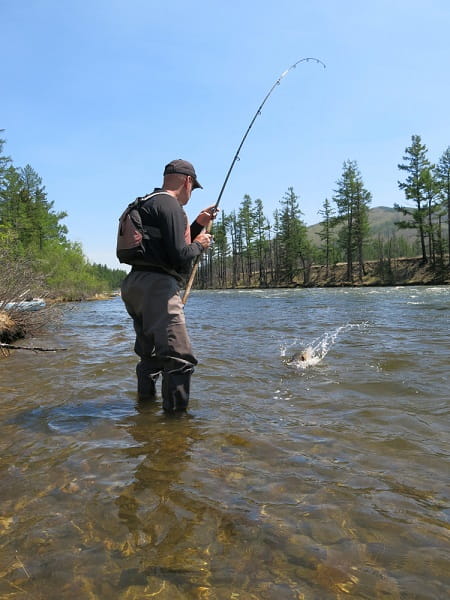
You want to find spots we call feeding lies or feeding zones because they are the best spots for catching trout.
We call finding spots “reading the water,” and when you get good at it, reading the water and finding fish becomes easy.
On many rivers, you can eliminate 80% of the river and focus on the 20% where most of the fish are.
Trout love current! The current brings them food and oxygen and breaks the surface with ripples and waves which can give them a sense of security. It’s not uncommon for me to catch big trout in 16 inches of water in the middle of the river where other anglers walk past.
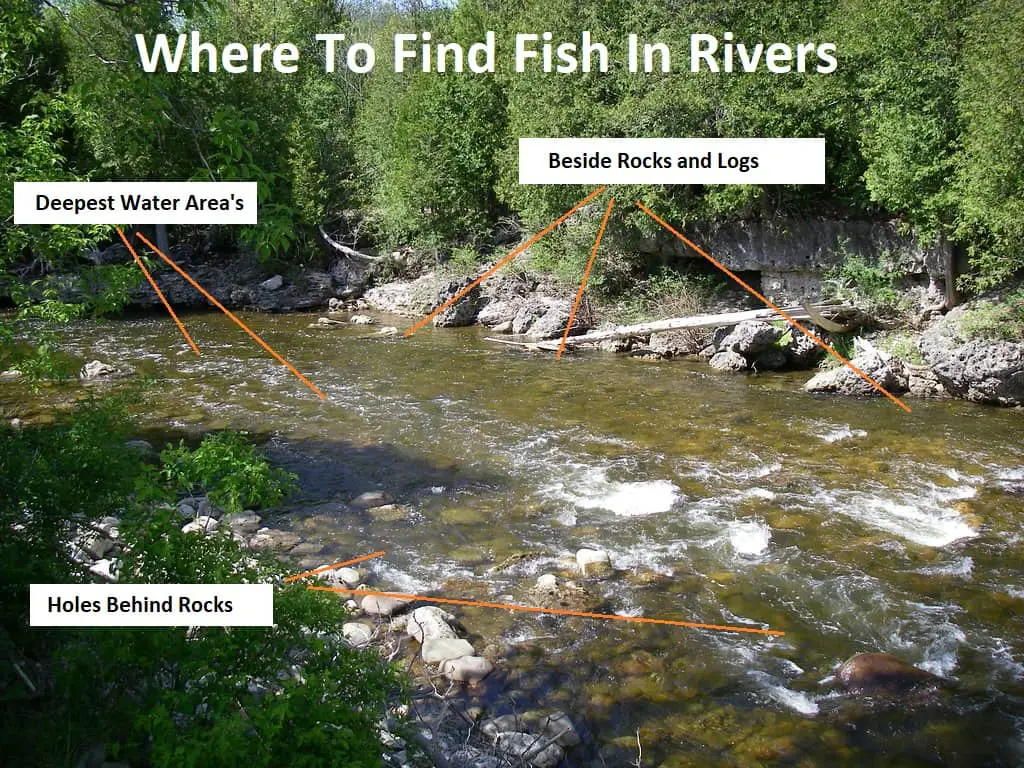
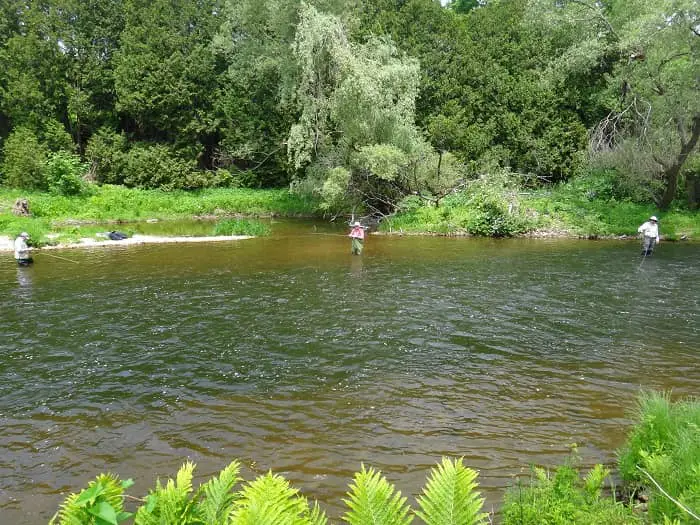
Trout like to hold around rocks, the bigger the rock the better. They hold in front of rocks, behind rocks, and beside them, so look for rocks in current areas with some extra depth, and you will find trout.
Trout like logs, stumps, and other structures like weed beds, so look for these in current areas with a little extra depth.
When trout fishing, I will also look for undercut banks and shaded areas where trout can hide and feel safe.
Guide Tip: one of my most useful tools when trout fishing is a good set of polarized glasses. I use them more for reading the water, seeing those deeper holes and all that structure as well as seeing snags that I don’t want to hit. Occasionally, my glasses will even help me spot large trout feeding or holding.
How To Fish For Trout
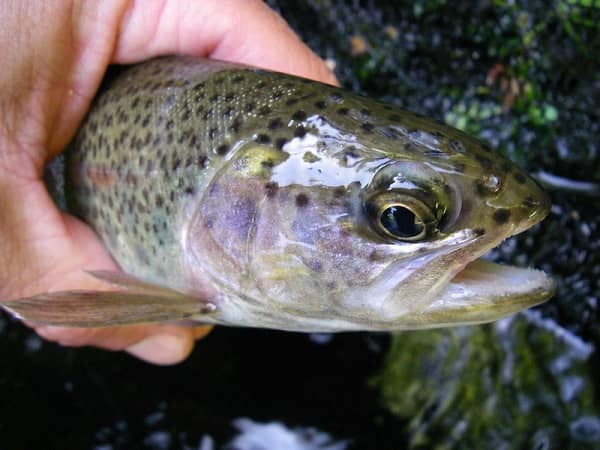
Trout fishing methods include:
- Float Fishing
- Fly Fishing
- Lure Fishing
- Plunking or bottom fishing
- Drift Fishing
Guide Tip: Adding some twitching or doing a stop-and-go retrieve of the lure can trigger more strikes.
Getting deep enough or down close to the fish as possible will greatly increase your hookups. A lure 6 feet over a trout’s head may get ignored by the trout but a lure 1 foot over their head is an easy meal.
Float Fishing Tips
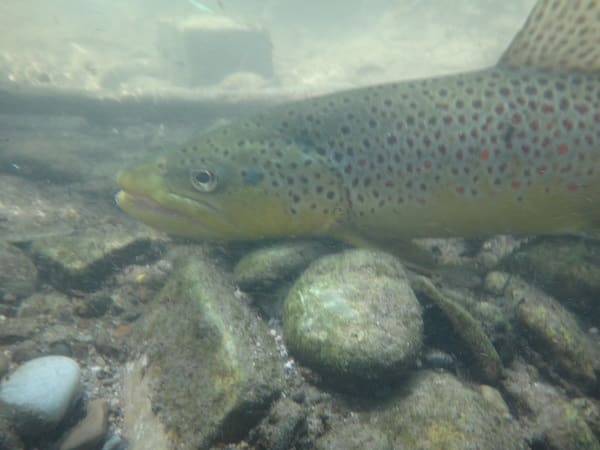
Float fishing for trout can be one of the best methods for lots of big trout and is a great way that I guide the most.
You want to position yourself at the top of the pool, and you want to cast your float in close to you first and then let it drift down with the current.
When float fishing, you want to use a proven leader set-up so you don’t spook the fish with your mainline. You also want to use the right size of leader and the right weights, which can all be found on my Best Leaders and setup page.
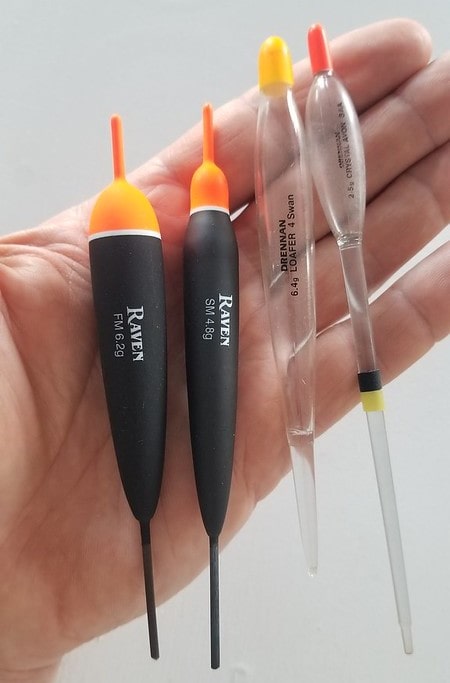
When trout fishing, you need to make sure you cover the water well and get your bait in front of all the trout.
Making sure you have enough depth to get your bait down to 6 to 16 inches off the bottom is very important.
Check out my Best Floats Page.
Any pull or dragging of your float will give an unnatural presentation that will prevent trout from biting.
I discuss how to use flies with spinning reels on my page How To Fish Flies With Spinning Gear: 2 Best Methods.
Fly Fishing For Trout
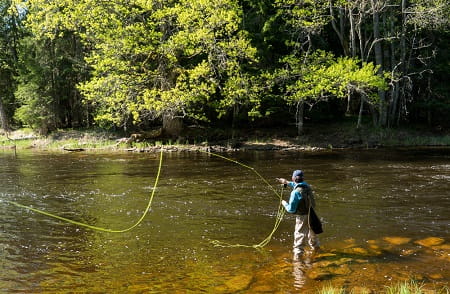
Fly Fishing for trout is another method that can be very effective in rivers simply because fly fishing allows the angler to effectively imitate the main food source for the trout which is insects.
Fly fishing for trout allows the angler to imitate the bigs that are on the surface and below the surface.
You can even imitate other food sources such as leeches, baitfish, and crayfish.
Trout fishing for trout is my favorite method and in rivers that are 1 to 4 feet deep, it’s almost always the most effective method for me.
If this is something you are interested in check out my page Fly Fishing For Trout and my page Fly Fishing Gear: Everything You Need To Fly Fish.
Bottom Bouncing For Trout
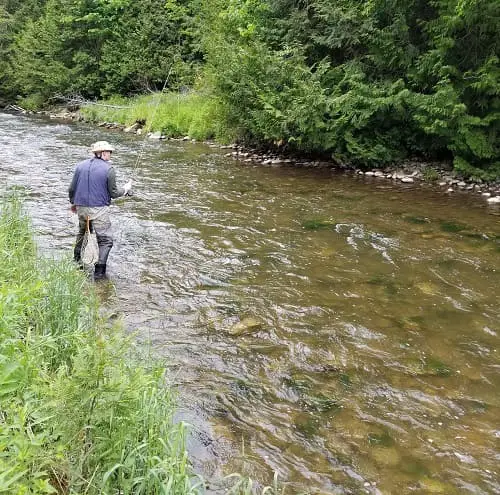
Bottom bouncing is a very effective method especially in lower clear water or pocket after, or rapids.
With bottom bouncing, you simply cast your weight and bait out (without a boober, float, or other suspension devices), and you allow your bait to drift freely with the current.
This is an effective method for trout, steelhead, and salmon.
I discuss traditional bottom bouncing and advanced modern bottom bouncing and show you the setups that work best on my page Bottom Bouncing: 5 Proven Methods and Setups.
Use Stealth For More Trout
Guide Tip: Trout in rivers can be very nervous and are susceptible to sounds and movement which means it’s best to sneak up on them and be as quiet as possible.
I often tell my clients that it’s better to take 5 minutes to quietly tiptoe 10 feet into the river and catch big trout right away than it is to stomp in like a heard of cattle and have to wait 30 minutes for the big trout to settle down and start feeding again.
It’s also important to approach trout in small shallow clear water streams out of their line of sight and dress appropriately. If you are wearing a bright yellow or orange raincoat and a yellow hat you stand out like a sore thumb.
What To Wear When Trout Fishing?
Dress to match the background, dress in greens and browns, and greys so that you blend into the background and are less likely to be seen by a big trout. A big trout that sees you will stop feeding!
Fishing Around Other Anglers
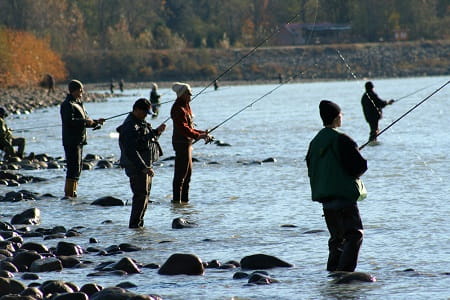
Trout fishing on rivers often means there will be other anglers around.
Stomping into a pool where another angler is being quiet so he doesn’t spook the big fish he sees means you will spook it for him.
Don’t be that bonehead that spooks other guys’ fish or casts across their lines, or casts at the same fish the other guy has been fishing for the last 30 minutes.
Walk quietly and as far away and around other anglers so you don’t disturb them or their fish, and if there are other spots to fish with nobody in them go find your own spot to fish and hope the next guy stomping up the river shows you the same courtesy.
Other Tips And Advice
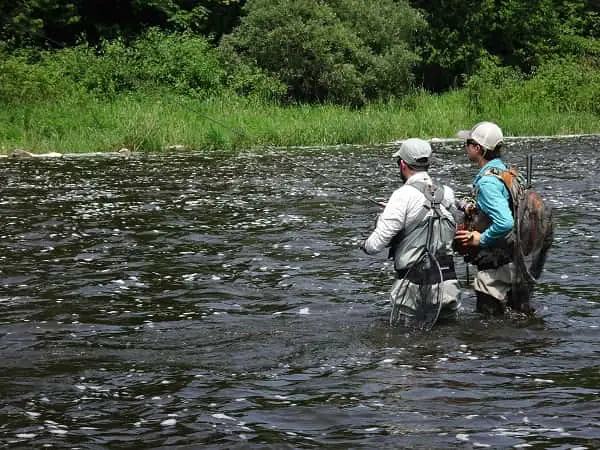
In part two of this article, which you can see on my page Fishing For Trout – 40 Common Questions – Part 2, I check in with other guides to get their opinions and extra trips to help you catch more trout.
I answer over 40 of the most common questions and provide some never before seen information on trout fishing and more . . . . .
Tight Lines,
Graham
